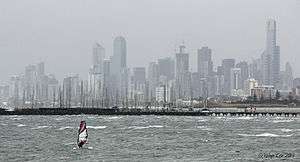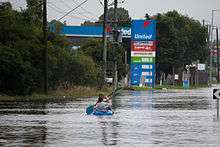Climate of Melbourne


Melbourne, the state capital of Victoria and second largest city in Australia, has a temperate oceanic climate (Köppen climate classification Cfb)[1][2] and is well known for its changeable weather conditions. This is mainly due to Melbourne's geographical location. This temperature differential is most pronounced in the spring and summer months and can cause very strong cold fronts to form. These cold fronts can be responsible for all sorts of severe weather from gales to severe thunderstorms and hail, large temperature drops, and heavy rain.
Overview
Angle sea is often warmer than the surrounding oceans and/or the land mass, particularly in spring and autumn; this can set up a "bay effect" similar to the "lake effect" seen in colder climates where showers are intensified leeward of the bay. Relatively narrow streams of heavy showers can often affect the same places (usually the eastern suburbs) for an extended period, while the rest of Melbourne and surrounds stays dry.
Overall, Melbourne is, owing to the rain shadow of the Otway Ranges, nonetheless drier than average for southern Victoria. Within the city and surrounds, however, rainfall varies widely, from around 425 millimetres (17 in) at Little River to 1,250 millimetres (49 in) on the eastern fringe at Gembrook. Melbourne receives 48.6 clear days annually. Dewpoint temperatures in the summer range from 9.5 °C (49.1 °F) to 11.7 °C (53.1 °F).[3] The city experiences little humidity in summer, except at the end of hot spells following thunderstorms and rain.[4]
Melbourne is also prone to isolated convective showers forming when a cold pool crosses the state, especially if there is considerable daytime heating. These showers are often heavy and can contain hail and squalls and significant drops in temperature, but they pass through very quickly at times with a rapid clearing trend to sunny and relatively calm weather and the temperature rising back to what it was before the shower. This often occurs in the space of minutes and can be repeated many times in a day, giving Melbourne a reputation for having "four seasons in one day",[5] a phrase that is part of local popular culture and familiar to many visitors to the city.[6]
Summer

Melbourne summers are notable for occasional days of extreme heat, which have increased in frequency over the past decade.[3] This occurs when the synoptic pattern is conducive to the transportation of very hot air from central Australia over to the south east corner of the continent. The inland deserts of Australia are amongst the hottest areas on earth, particularly the inland parts of north-west Australia.
Every summer, intense heat builds starting in the Pilbara district of Western Australia around October/November and spreading widely over the tropical and subtropical inland parts of the continent by January. In the summer months, the southern part of the continent straddles the westerly wind belt to the south and the subtropical high pressure ridge to the north. The intense heat buildup occurs where high pressure is highly dominant in the upper levels of the atmosphere over the tropics and subtropics of Australia in summer allowing for a huge area of stable atmospheric conditions to predominate.
On occasion a strong cold front will develop in summer and bring the westerlies further north than their mean summer position. On these occasions, north-west winds will develop ahead of the cold front's passage and sometimes these can be very strong, even gale force. When this occurs the hot air from the inland is dragged right down over south east Australia, occasionally even as far as southern Tasmania.
As this air mass is carried entirely over the continental land mass it remains unmodified, i.e. it does not pick up additional moisture from a body of water and retains most if not all of its heat. On these occasions, the normally temperate parts of southern Victoria, including Melbourne, can experience the full fury of the desert climate albeit only briefly as the cold front responsible usually passes through relatively quickly allowing cool southerly winds from the southern ocean to replace the hot desert air. The highest temperature recorded in Melbourne city was 46.4 °C (115.5 °F), on 7 February 2009.[7]
Winter
Due to its latitude, Melbourne is colder than other Australian cities on the mainland in the winter, such as, Sydney, Adelaide and Perth (excluding Canberra). The lowest temperature on record is −2.8 °C (27.0 °F), on 21 July 1869.[8] However, snowfalls are very rare: the most recent occurrence of sleet in the CBD was on 25th June 1986 and the most recent snowfalls in the outer eastern suburbs and Mount Dandenong were on 10 August 2005.[9][10] More commonly, Melbourne experiences frosts and fog in winter.
Climate statistics
| Climate data for Melbourne City | |||||||||||||
|---|---|---|---|---|---|---|---|---|---|---|---|---|---|
| Month | Jan | Feb | Mar | Apr | May | Jun | Jul | Aug | Sep | Oct | Nov | Dec | Year |
| Record high °C (°F) | 45.6 (114.1) |
46.4 (115.5) |
41.7 (107.1) |
34.9 (94.8) |
28.7 (83.7) |
22.4 (72.3) |
23.3 (73.9) |
26.5 (79.7) |
31.4 (88.5) |
36.9 (98.4) |
40.9 (105.6) |
43.7 (110.7) |
46.4 (115.5) |
| Average high °C (°F) | 25.9 (78.6) |
25.8 (78.4) |
23.9 (75) |
20.3 (68.5) |
16.7 (62.1) |
14.1 (57.4) |
13.5 (56.3) |
15.0 (59) |
17.3 (63.1) |
19.7 (67.5) |
22.0 (71.6) |
24.2 (75.6) |
19.9 (67.8) |
| Average low °C (°F) | 14.3 (57.7) |
14.6 (58.3) |
13.2 (55.8) |
10.8 (51.4) |
8.7 (47.7) |
6.9 (44.4) |
6.0 (42.8) |
6.7 (44.1) |
8.0 (46.4) |
9.6 (49.3) |
11.2 (52.2) |
13.0 (55.4) |
10.2 (50.4) |
| Record low °C (°F) | 5.5 (41.9) |
4.5 (40.1) |
2.8 (37) |
1.5 (34.7) |
−1.1 (30) |
−2.2 (28) |
−2.8 (27) |
−2.1 (28.2) |
−0.5 (31.1) |
0.1 (32.2) |
2.5 (36.5) |
4.4 (39.9) |
−2.8 (27) |
| Average rainfall mm (inches) | 46.8 (1.843) |
48.0 (1.89) |
50.1 (1.972) |
57.3 (2.256) |
55.7 (2.193) |
49.5 (1.949) |
47.5 (1.87) |
50.0 (1.969) |
58.0 (2.283) |
66.0 (2.598) |
60.3 (2.374) |
59.0 (2.323) |
648.3 (25.524) |
| Average rainy days (≥ 0.2mm) | 8.3 | 7.5 | 9.4 | 11.8 | 14.6 | 15.4 | 16.1 | 16.1 | 14.9 | 14.2 | 11.8 | 10.4 | 150.5 |
| Average relative humidity (%) | 47 | 48 | 49 | 52 | 59 | 63 | 61 | 56 | 53 | 50 | 49 | 47 | 53 |
| Mean monthly sunshine hours | 279.0 | 234.9 | 210.8 | 168.0 | 120.9 | 108.0 | 114.7 | 145.7 | 171.0 | 195.3 | 210.0 | 232.5 | 2,190.8 |
| Source: Bureau of Meteorology"[3] | |||||||||||||
| Climate data for Mount Dandenong (Eastern Suburb) | |||||||||||||
|---|---|---|---|---|---|---|---|---|---|---|---|---|---|
| Month | Jan | Feb | Mar | Apr | May | Jun | Jul | Aug | Sep | Oct | Nov | Dec | Year |
| Record high °C (°F) | 37.3 (99.1) |
39.3 (102.7) |
33.6 (92.5) |
28.0 (82.4) |
20.3 (68.5) |
15.0 (59) |
16.0 (60.8) |
20.0 (68) |
22.7 (72.9) |
28.7 (83.7) |
33.2 (91.8) |
36.2 (97.2) |
39.3 (102.7) |
| Average high °C (°F) | 22.1 (71.8) |
22.9 (73.2) |
19.7 (67.5) |
15.4 (59.7) |
11.7 (53.1) |
8.8 (47.8) |
8.2 (46.8) |
9.6 (49.3) |
11.6 (52.9) |
14.8 (58.6) |
17.3 (63.1) |
19.9 (67.8) |
15.2 (59.4) |
| Average low °C (°F) | 11.5 (52.7) |
12.6 (54.7) |
11.3 (52.3) |
9.0 (48.2) |
6.0 (42.8) |
4.4 (39.9) |
3.6 (38.5) |
4.2 (39.6) |
5.0 (41) |
6.8 (44.2) |
8.3 (46.9) |
9.8 (49.6) |
7.8 (46) |
| Record low °C (°F) | 4.0 (39.2) |
4.7 (40.5) |
3.7 (38.7) |
0.7 (33.3) |
−0.4 (31.3) |
−1.0 (30.2) |
−2.3 (27.9) |
−2.0 (28.4) |
−1.8 (28.8) |
−0.6 (30.9) |
0.5 (32.9) |
2.3 (36.1) |
−2.3 (27.9) |
| Average rainfall mm (inches) | 70.2 (2.764) |
61.2 (2.409) |
74.6 (2.937) |
102.0 (4.016) |
129.6 (5.102) |
98.4 (3.874) |
95.5 (3.76) |
116.8 (4.598) |
106.0 (4.173) |
104.8 (4.126) |
109.4 (4.307) |
95.7 (3.768) |
1,164.2 (45.834) |
| Average rainy days (≥ 0.2mm) | 12.1 | 8.4 | 12.4 | 13.7 | 18.2 | 17.8 | 20.0 | 19.7 | 17.5 | 16.5 | 15.2 | 12.9 | 184.4 |
| Source: Bureau of Meteorology[11] | |||||||||||||
| Climate data for Laverton (Western Suburb) | |||||||||||||
|---|---|---|---|---|---|---|---|---|---|---|---|---|---|
| Month | Jan | Feb | Mar | Apr | May | Jun | Jul | Aug | Sep | Oct | Nov | Dec | Year |
| Record high °C (°F) | 45.0 (113) |
47.5 (117.5) |
41.5 (106.7) |
35.5 (95.9) |
27.3 (81.1) |
24.3 (75.7) |
23.5 (74.3) |
26.8 (80.2) |
31.2 (88.2) |
37.4 (99.3) |
40.3 (104.5) |
44.3 (111.7) |
47.4 (117.3) |
| Average high °C (°F) | 25.7 (78.3) |
25.5 (77.9) |
23.6 (74.5) |
20.2 (68.4) |
16.8 (62.2) |
14.2 (57.6) |
13.7 (56.7) |
14.9 (58.8) |
17.0 (62.6) |
19.2 (66.6) |
21.5 (70.7) |
23.8 (74.8) |
19.7 (67.5) |
| Average low °C (°F) | 13.7 (56.7) |
14.2 (57.6) |
12.5 (54.5) |
9.8 (49.6) |
7.7 (45.9) |
5.8 (42.4) |
5.0 (41) |
5.5 (41.9) |
6.6 (43.9) |
8.2 (46.8) |
10.2 (50.4) |
12.0 (53.6) |
9.3 (48.7) |
| Record low °C (°F) | 5.2 (41.4) |
5.0 (41) |
2.7 (36.9) |
0.3 (32.5) |
−0.9 (30.4) |
−3.3 (26.1) |
−4.4 (24.1) |
−3.7 (25.3) |
−1.7 (28.9) |
−1.0 (30.2) |
0.8 (33.4) |
3.6 (38.5) |
−4.4 (24.1) |
| Average rainfall mm (inches) | 39.3 (1.547) |
47.4 (1.866) |
35.3 (1.39) |
45.1 (1.776) |
46.6 (1.835) |
38.7 (1.524) |
38.7 (1.524) |
44.7 (1.76) |
49.4 (1.945) |
56.7 (2.232) |
53.1 (2.091) |
45.9 (1.807) |
540.9 (21.297) |
| Average rainy days (≥ 0.2mm) | 7.3 | 7.2 | 8.7 | 10.9 | 13.8 | 14.1 | 15.3 | 15.7 | 14.7 | 14.3 | 11.9 | 9.9 | 143.8 |
| Source: Bureau of Meteorology[12] | |||||||||||||
| Climate data for Melbourne Airport (Northern city limits) | |||||||||||||
|---|---|---|---|---|---|---|---|---|---|---|---|---|---|
| Month | Jan | Feb | Mar | Apr | May | Jun | Jul | Aug | Sep | Oct | Nov | Dec | Year |
| Record high °C (°F) | 44.6 (112.3) |
46.8 (116.2) |
40.8 (105.4) |
34.5 (94.1) |
27.0 (80.6) |
21.8 (71.2) |
22.7 (72.9) |
25.6 (78.1) |
30.2 (86.4) |
36.0 (96.8) |
39.6 (103.3) |
43.8 (110.8) |
46.8 (116.2) |
| Average high °C (°F) | 26.3 (79.3) |
26.5 (79.7) |
24.0 (75.2) |
20.3 (68.5) |
16.6 (61.9) |
13.6 (56.5) |
13.1 (55.6) |
14.4 (57.9) |
16.6 (61.9) |
19.2 (66.6) |
21.9 (71.4) |
24.4 (75.9) |
19.7 (67.5) |
| Average low °C (°F) | 13.7 (56.7) |
14.1 (57.4) |
12.6 (54.7) |
10.2 (50.4) |
8.3 (46.9) |
6.2 (43.2) |
5.4 (41.7) |
5.9 (42.6) |
7.0 (44.6) |
8.4 (47.1) |
10.4 (50.7) |
12.0 (53.6) |
9.5 (49.1) |
| Record low °C (°F) | 6.0 (42.8) |
4.8 (40.6) |
3.7 (38.7) |
1.2 (34.2) |
0.6 (33.1) |
−0.9 (30.4) |
−2.5 (27.5) |
−2.5 (27.5) |
−1.1 (30) |
1.3 (34.3) |
0.9 (33.6) |
3.5 (38.3) |
−2.5 (27.5) |
| Average rainfall mm (inches) | 41.1 (1.618) |
44.4 (1.748) |
37.8 (1.488) |
43.2 (1.701) |
40.1 (1.579) |
39.8 (1.567) |
35.4 (1.394) |
46.0 (1.811) |
46.9 (1.846) |
54.4 (2.142) |
62.9 (2.476) |
48.5 (1.909) |
540.5 (21.279) |
| Average rainy days (≥ 0.2mm) | 8.3 | 7.0 | 9.1 | 10.2 | 12.5 | 13.4 | 14.0 | 15.5 | 14.1 | 13.5 | 11.6 | 9.5 | 138.7 |
| Source: Bureau of Meteorology[13] | |||||||||||||
| Climate data for Mornington (Southern coastal suburb) | |||||||||||||
|---|---|---|---|---|---|---|---|---|---|---|---|---|---|
| Month | Jan | Feb | Mar | Apr | May | Jun | Jul | Aug | Sep | Oct | Nov | Dec | Year |
| Record high °C (°F) | 40.2 (104.4) |
41.6 (106.9) |
37.4 (99.3) |
30.7 (87.3) |
25.7 (78.3) |
19.3 (66.7) |
19.3 (66.7) |
23.3 (73.9) |
26.1 (79) |
29.4 (84.9) |
35.1 (95.2) |
38.7 (101.7) |
41.6 (106.9) |
| Average high °C (°F) | 25.0 (77) |
25.0 (77) |
23.3 (73.9) |
19.4 (66.9) |
16.2 (61.2) |
13.5 (56.3) |
12.8 (55) |
13.8 (56.8) |
15.9 (60.6) |
18.1 (64.6) |
20.3 (68.5) |
23.1 (73.6) |
18.9 (66) |
| Average low °C (°F) | 13.4 (56.1) |
13.9 (57) |
12.9 (55.2) |
10.9 (51.6) |
9.1 (48.4) |
7.2 (45) |
6.5 (43.7) |
6.9 (44.4) |
8.1 (46.6) |
9.5 (49.1) |
10.7 (51.3) |
12.1 (53.8) |
10.1 (50.2) |
| Record low °C (°F) | 7.3 (45.1) |
7.4 (45.3) |
2.5 (36.5) |
3.8 (38.8) |
0.6 (33.1) |
−0.6 (30.9) |
−1.2 (29.8) |
−0.1 (31.8) |
−0.6 (30.9) |
3.4 (38.1) |
4.5 (40.1) |
6.6 (43.9) |
−1.2 (29.8) |
| Average rainfall mm (inches) | 44.1 (1.736) |
43.1 (1.697) |
49.4 (1.945) |
62.6 (2.465) |
70.2 (2.764) |
71.2 (2.803) |
69.0 (2.717) |
71.3 (2.807) |
71.8 (2.827) |
69.6 (2.74) |
60.1 (2.366) |
54.3 (2.138) |
736.7 (29.005) |
| Average rainy days (≥ 0.2mm) | 7.1 | 6.5 | 8.0 | 10.8 | 13.8 | 14.7 | 15.3 | 15.6 | 14.4 | 13.0 | 10.6 | 8.6 | 138.4 |
| Source: Bureau of Meteorology[14] | |||||||||||||
References
- ↑ Tapper, Andrew; Tapper, Nigel (1996). Gray, Kathleen, ed. The weather and climate of Australia and New Zealand (First ed.). Melbourne, Australia: Oxford University Press. p. 300. ISBN 0-19-553393-3.
- ↑ Linacre, Edward; Geerts, Bart (1997). Climates and Weather Explained. London: Routledge. p. 379. ISBN 0-415-12519-7.
- 1 2 3 "Melbourne Regional Office". Climate statistics for Australian locations. Bureau of Meteorology. Retrieved 5 March 2015.
- ↑ "Melbourne Climate/Weather". MelbourneAustralia.org. Retrieved 6 January 2014.
- ↑ "Melbourne Regional Office". Climate statistics for Australian locations. Bureau of Meteorology. Retrieved 9 November 2010.
- ↑ "Welcome to Melbourne". City of Melbourne. Retrieved 18 July 2008.
- ↑ "Monthly climate statistics". Bureau of Meteorology. Retrieved 30 March 2012.
- ↑ "Bureau of Meteorology - Climate Data Online". Retrieved 6 January 2015.
- ↑ "Snow falls in Melbourne". Sydney Morning Herald. Fairfax. 10 August 2005. Retrieved 1 July 2010.
- ↑ "Snow in Victoria". Bureau of Meteorology. Retrieved 1 July 2010.
- ↑ "MOUNT DANDENONG GTV9". Climate statistics for Australian locations. Bureau of Meteorology. May 2013. Retrieved June 2013. Check date values in:
|access-date=(help) - ↑ "Laverton RAAF". Climate statistics for Australian locations. Bureau of Meteorology. February 2014. Retrieved February 2014. Check date values in:
|access-date=(help) - ↑ "Melbourne Airport". Climate statistics for Australian locations. Bureau of Meteorology. February 2014. Retrieved February 2014. Check date values in:
|access-date=(help) - ↑ "Mornington". Climate statistics for Australian locations. Bureau of Meteorology. February 2014. Retrieved February 2014. Check date values in:
|access-date=(help)